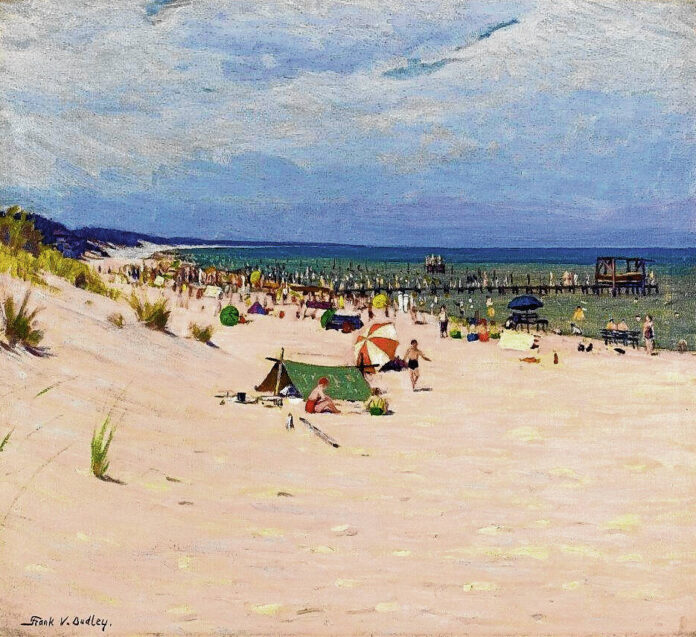Indiana Dunes has an aura and an attraction that has made it one of the state’s most popular places.
Millions of people are drawn to the shore every year to hike the shifting sands, plunge deep into woodland environments and splash in the waters of Lake Michigan. Nature lovers can find migrating birds and animals such as red fox, beaver, and white-tailed deer. They enjoy the quiet winter mornings in the woods and the majesty of summertime sunsets over the water.
Frank Dudley understood all of this.
“(The Dunes) were being threatened by encroaching industry and neglect, and Dudley and other organizations and individuals stepped up to make it their lives’ work to preserve this landscape,” said Mark Ruschman, senior curator of fine arts at the Indiana State Museum.
Throughout his career, Dudley worked to capture the rare beauty of Indiana Dunes. His paintings looked at the natural wonders in all kinds of light, weather and seasons. By promoting the beautiful landscape, he helped inspire preservation, document ecology, and promote land use around the dunes.
The art is the focus of “Inspired by the Dunes: Paintings by Frank K. Dudley,” an exhibit now showing at the Indiana State Museum. Visitors are taken through 28 of Dudley’s paintings, can step into one of his beach scenes and learn about this life. The exhibit shows how he influences authors, photographers, poets and other artists, including contemporary artists.
“We want people to learn about Dudley, and what a fabulous artist he was. But also, through his artwork and initiatives, we want to show that art can have the power to persuade people to act,” Ruschman said.
Though he was born in Delevan, Wisconsin, in 1868, Dudley spent a good portion of his adult life living in Chicago, where he painted mostly landscapes and still-lifes. His first experience with the Indiana Dunes came in about 1908, when his brother Clarence, would take trips out to the landside landscape. At the time, it was all wide-open land; the Dunes would not become a state park for another 17 years.
Dudley, who became known as “The Painter of the Dunes,” is said to initially have had reservations about the landscape, but he came around to paint them almost exclusively starting in 1917 until his death in 1957. In 1923, he and his wife, Maida, built a cottage at the Dunes and spent summers there.
A few years after the state park was founded, Dudley’s cottage became state property, requiring the couple to pay rent. But in lieu of payment, the state agreed to accept a painting a year as payment.
Nineteen of the so-called “rental paintings” are in the Indiana State Museum’s permanent collection. The state also purchased 53 of Dudley’s paintings after his death — selections of which are included in “Inspired by the Dunes.”
With the Indiana State Museum’s extensive colletion of Dudley’s work, it made sense to create an exhibition that looked at his contributions to art.
“Dudley is a significant part of our fine art collection — it’s probably our second-largest holdings next to T.C. Steele,” Ruschman said. “We had quite a few paintings to choose from, and it gives us an excellent opportunity to showcase our permanent collection and highlight the work on an important artist.”
In telling Dudley’s story, museum officials wanted to offer interactive and immersive ways to experience the Dunes. The exhibit is not told in chronological order, working through Dudley’s career, but through the ways in which he became engaged in the landscape.
Ruschman tried to use his paintings to talk about the ecosystem of the Dunes.
“Through his efforts, not only were they beautiful paintings, but they were documenting the detail and the ecosystem of the it, which tells a rich history in and of itself,” he said.
People have the chance to step into a life-size photo opportunity from one of Dudley’s beach scenes. They’ll learn how sand dunes were created, and the unique plants, animals and other wildlife that have thrived there.
As a companion to Dudley’s work, guests can experience the Dunes from a contemporary perspective through the textiles and ceramics of Jason Wesaw, a celebrated Native American artist and member of the Potawatomi Nation.
“In addition to creating beautiful paintings, his story includes that of conservation, and making all efforts possible to preserve the Dunes,” Ruschman said.





